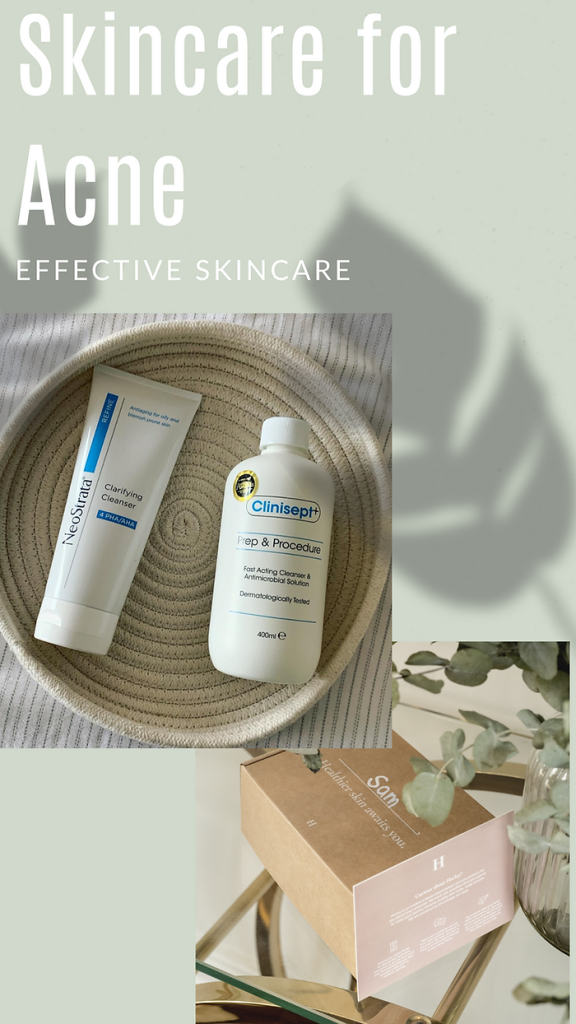What is acne?
Acne is a simple medical word for spots. It is very common chronic inflammatory skin condition. 6 types of spots caused by acne: blackheads, whiteheads, nodules, cysts and pustules.
Acne is believed to occur when the sebaceous glands of the skin produce too much oil (sebum), which, along with dead skin cells, blocks the pores in the skin resulting in blackheads or whiteheads. Pus-filled spots can then occur when particular strains of a bacterium normally found on the skin called Propionibacterium acnes becomes enriched in the oily environment triggering inflammation (British Skin Foundation).
Here I am discussing mild/moderate conditions and maintenance. Always seek a dermatologist advised if at home skincare is not helping your acne.
What causes Acne?
Testosterone during Puberty
The increase in testosterone is essential in our development during puberty. This hormonal influx increases size and activity of sebaceous glands.
Hereditary
Studies have shown if your parents had acne, you are more likely to develop it.
Hormones in women
Due to hormonal changes acne is more common at times during Pregnancy, Menstruation and in polycystic ovaries syndrome.
Why do we get acne before our periods?
Just before your period, female hormones drop and our androgen (type of male hormone) increases. These act on the sebaceous glands via receptors, which increase in size and increase sebum production. This causes the acne surge during pre-menstruation.
Polycystic ovaries impact on Acne?
Studies have shown up to 37% of women with moderate to severe acne will show symptoms of PCOS. This is why I urge you to see a GP or women’s health specialist if you suspect this.
How to treat and Acne.
It is tempting to be harsh with acne but this does not help the healing process. We must treat it gently and carefully. With certain products and medications the skin can become dry, compromised and inflamed. Each individually has a very different and complex acne pathway, which means these guidelines, can be adapted.
This is a guide for mild to moderate acne, and maintenance.
1.Stop the cells which are shedding within the pores and sticking together. Retinoid and retinols can achieve this goal by reducing the stickiness of exfoliated cells.
2. Eliminating bacteria with an antibacterial solution. I advise the anti-microbial Clinisept for this. This has a skin neutral pH so non-irritating and non-toxic. It is a highly effective anti-microbial which reduces redness and inflammation too. It is perfect for sensitive skin.
3. Now we need to remove the clogging material within the pore. This can be done with Beta Hydroxy Acids (BHA) and Alpha Hydroxy Acids (AHA). BHA like salicylic acid is lipid soluble therefore is needed to deeply unclog excess sebum and dead cells. Clarifying cleanser by Neostrata works well here as it contains a mix of AHA’s, BHA’s and PHA’s.
4. Attacking the inflammatory response. The redness and inflammation can be calmed with Clinisept and BHA’s
5. Decreasing the level of sebum production will help reduce acne formation. Retinol and retinoids are again necessary for this. Skinbetter Alpharet is a combination of AHA’s and Retinoid, with minimum irritation.
6. Moisturisation is important for acne. Good hydration of the skin improves the health and barrier function. We want to use a moisturiser, which does not contain oil, potent hydration and mild acids. Bio-hydrating cream is full of Gluconolactone, which has many functions and is advised for acne prone skin.
Acne healing takes time
The process can take time, we need to be patient with the skin and allow it to heal slowing.
#acne #acnetreatment #glowingskin #retinol #skincare

